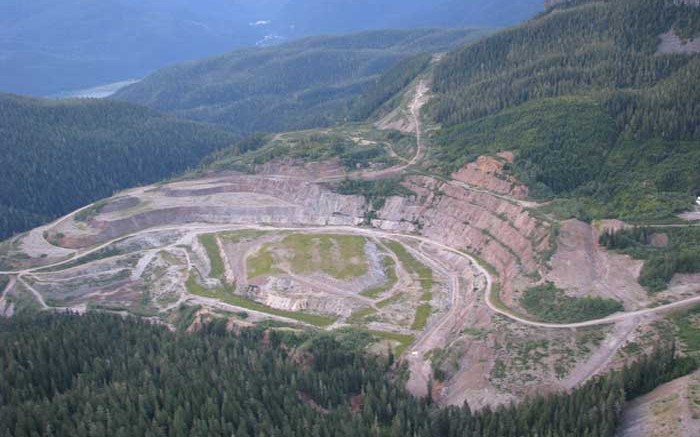VANCOUVER — Avanti Mining (TSXV: AVT; US-OTC: AVNMF) has been quietly going about its business over the past three years, and now the company has a clear path towards restarting production at the historic Kitsault molybdenum mine, 140 km north of Prince Rupert, B.C. On June 16 B.C.’s Ministry of Energy and Mines granted Avanti its Mines Act permit, which allows for mine site construction to get underway next year. The company has laready embarked on road construction activities.
Avanti describes Kitsault as “one of the top-five primary molybdenum development assets worldwide.”
The company acquired Kitsault for $20 million in 2008, and since then it has directed most of its efforts towards permitting, community engagement and social licensing. Avanti was granted provincial approval of its environmental assessment (EA) in March 2013, and is in the final stages of its federal environmental review.
There have been social licence pitfalls for B.C. miners, but Avanti looks to have forged good relations with local First Nations. The company ran into opposition from the Nisga’a Nation in mid-2013, but the parties reached a benefits agreement in June 2014 that includes a net smelter return royalty (NSR) for the Nisga’a of up to 2%, based on prevailing moly prices.
“We wish to congratulate [Avanti’s executive team,] who approached us with a sincere interest in addressing our concerns with the project, which we were then able to work through without delay,” Nisga’a Nation president Mitchell Stevens said. “This demonstrates that when proponents take [our] interests and concerns seriously, practical agreements can be reached in a timely manner.”
The agreement followed a memorandum of understanding with the Wilp Luuxhon Nation in January that includes road maintenance contracts, training and investment in local business.
Metal markets are also working in Avanti’s favour, with the price for molybdenum oxide sitting at a 52-week high of US$15 per lb. at press time. The company released an updated feasibility study on Kitsault in April, which optimizes the mine plan.
Avanti’s new study has slightly larger proven and probable reserves of 231 million tonnes grading 0.082% moly for 420 million contained lb., and lowers development costs by 13% to US$818 million.
Kitsault’s economics have improved, with the mine’s after-tax net present value (NPV) at an 8% discount rate coming in at $472 million, while the internal rate of return (IRR) sits at 19%. Payback of the initial capital is pegged at four years.
This compares to a $433-million after-tax NPV and a 16.6% IRR under a feasibility study completed on the project in early 2013. Both studies assume US$14.50 per lb. moly.
Avanti Mining president and CEO Gordon Bogden noted that the Mines Act permit “is a forerunner for other corollary leases and licences that are anticipated within a few days, and which will allow us to commence road and camp construction at site . . . in the meantime, Avanti continues its project debt negotiations with its banking syndicate, while it explores in parallel a number of other financing sources, such as a sale of a silver stream, and investment by a strategic partner.”
U.S.-based private equity group Resource Capital gave Avanti a US$50-million pre-construction loan in December that allows the company to begin work at the site, which has been vacant since the operation was shut down in 1982.
Kitsault could employ 700 people during a two-year construction period and 300 full-time workers during operations. The mine could produce 45,500 tonnes of ore per day during its 14-year mine life.
The life-of-mine molybdenum production is estimated at 367 million lb. moly contained in about 343,000 wet tonnes of moly concentrate produced from the processing of 226 million tonnes of ore grading 0.083% molybdenum. Life-of-mine by-product silver output would total 15.2 million oz.
The company has also secured project financing mandates and off-take agreements. Last year Germany’s ThyssenKrupp Metallurgical Products agreed to buy half of the total moly production over Kitsault’s life, which could mean US$2.7 billion in revenue. The agreement includes a proposed mandate for US$300 million in financing for mine development.
In April Avanti followed up with an off-take agreement with South Korea’s SeAH M&S Corp for up to 20% of Kitsault’s moly production over 13 years, which represents US$800 million in revenues at current moly prices. The agreement with SeAH M&S is conditional on participation of a Korean bank or other Korean lender in a second tranche of the project debt facility.
Avanti expects engineering and procurement to be 65% complete by year-end.
Shares have traded within a 52-week range of 4¢ to 14¢, and were up 144% in April en route to an 11¢-per-share close at press time. Avanti has 468 million shares outstanding for a $52-million market capitalization.


Things you do not know all the greenwood Envro people work for a person which works in the Vancouver Anvanti Kitsault Mine. which this person ownes the Grreenwood company and HE is working for Avanti. All Envro matters which are going on at the mine site is crazy.They are building a road and dumping mud into a flowing creeks which goes into the ocean. This happening when the Envro people are not here. other things are the water they use for camp it not treated it comes from a lake which haves lava eggs in it and are using for showers and other things I do not want to say. Plus they not telling the truth about the % which will be mined I was told the % is much lower then being told.You have to ask yourself this mine was mined for many years before and alot was taking out before.
I worked in kitsault in 1980 and would love to work there again, except this time as an HSE officer rather than a cat operator